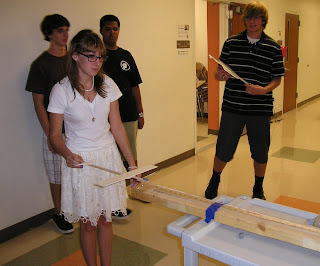 Congratulations to Seminole SECME students Daniel Ingelias and Deanna Beckham. Daniel and Deanna won first place yesterday during the hoop glider ans SAE AWIM competitions respectively, with far flung flyers that flew 29 feet 6 inches.
Congratulations to Seminole SECME students Daniel Ingelias and Deanna Beckham. Daniel and Deanna won first place yesterday during the hoop glider ans SAE AWIM competitions respectively, with far flung flyers that flew 29 feet 6 inches.HOOP GLIDER
ENGAGE
If you throw a plain straw, it doesn’t go very far. But when you add paper hoops, the straw glides through the air!
EXPLAIN
It’s because the hoops act like wings. Things that fly, like insects, birds, and airplanes all have wings. But wings are not all the same shape and size. Different wings can be better for different kinds of flight. For example, an eagle has long, wide wings that help it glide. An airplane has wings with small flaps that move up and down to turn the plane. Try changing the wings on your glider. How does it fly with different wings?
EXPLORE
What you need: • Paper • Ruler • Scissors • Pencil • Tape • Non-bendable, plastic drinking straw
What to do:
1.Cut two strips of paper. Make one strip 1 inch wide and 5 inches long. Make the second strip 1 inch wide and 10 inches long.
2.Curl each paper strip into a hoop. Tape the ends together. Now you have a big hoop and a small hoop.
3.Tape the small hoop to one end of the straw.
4.Tape the big hoop on the other end of the straw. Make sure the big hoop lines up with the small hoop.
ELABORATE
Newton's 3rd Law of Motion: For every action, there is an equal and opposite reaction. Thrust is the force exerted when to throw a hoop glider. Drag (or air resistance) is the reaction force against thrust. The more "stuff" there is, the harder it is to move that stuff through the air. Lift is the force that keeps a hoop glider up in the air. The curved surface of the hoop glider's loops create a difference in pressure above and below the loops, which deflects the hoop up. Gravity is the reaction force, pulling the glider down toward the center of the Earth. Gravity is a constant and cannot be changed. But by maximizing lift, minimizing drag and with just the right amount and direction of thrust, hoop gliders can fly quite far!
EVALUATE
Hold your Hoop Glider in the middle of the straw, with the small hoop in front. Throw it gently like a spear. It might take some practice to get the hang of it. How far does your glider fly?
EXTEND What will happen if . . .
Choose one thing to change (that’s the variable), and predict what you think will happen, then test it! Other websites to check out
----- ----- ----- ----- ----- ----- ----- ----- -----
 SAE A World In Motion - Glider Challenge
SAE A World In Motion - Glider ChallengeSAE International's A World In Motion® (AWIM) is a teacher-administered, industry volunteer-assisted program that brings science, technology, engineering and math (STEM) education to life in the classroom for students in Kindergarten through Grade 12. Benchmarked to the national standards, AWIM incorporates the laws of physics, motion, flight and electronics into age-appropriate hands on activities that reinforce classroom STEM curriculum.
The standard model enables students to examine the effects of adjusting the positions of the wings, the stabilizer assembly, and adding weight to the model. In this activity, students become acquainted with the Standard Model. They invent their own ways to arrange the balsa fuselage stick, the wing, and the stabilizer assembly.
They test fly the Standard Model in these different configurations, observe its flight path, and discover that some configurations result in better flights than others.

Students are introduced to the concepts of balance and center of gravity as factors to consider in flying their gliders.

Students explore the relationship between force and motion.
.JPG)
Students explore the effects of weight and lift on a glider.
.JPG)
Students learn the relationships between data analysis and variable manipulations.
Through the support of corporations, foundations, volunteers, SAE members and the SAE Foundation, A World In Motion opens a window of possibilities for students as they discover the exciting application of science principles and learn about rewarding engineering, science and technical careers. The students learn to work as a team with their classmates and apply creative problem solving during the activities.
